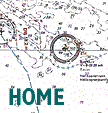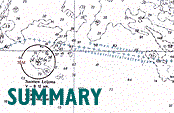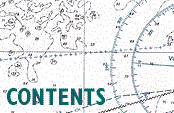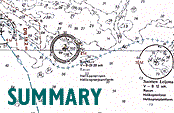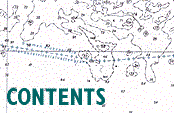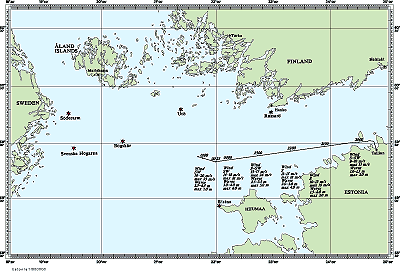 |
13.2.1 Introduction
The general course of events described in this section has been plotted from observations on the wreck, analysis of statements by witnesses, analysis of the damage and evaluation of the strength of the visor and ramp attachments. Calculations and model tests of the vessel's behaviour in waves have also been used. Specific parts of the sequence of events are detailed in 13.3 to 13.6. In Figure 13.2. the course of events is illustrated.
Figure 13.2 Course of events as composed by the Navigation Simulator at the Maritime Academy in Kalmar, Sweden.
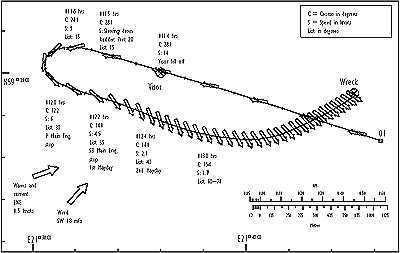 Click image for close-up
Click image for close-up
The Commission has analysed 258 statements from 134 survivors. The Commission is aware that none of the survivors is a witness proper, in the sense of an observer. All the witnesses are victims of the accident, involved in it and a part of the chain of events. Their observations and recollections are thus influenced by prolonged anxiety, exhaustion and stress. All statements are furthermore restricted to individual experience on board and outside the vessel only, and no witnesses have had any possibility of gaining an overall view.
 When analysing the chain of events the Commission has usually put somewhat more emphasis on earlier statements than on later ones. The reason for this is that earlier statements were made at a time when witnesses' recollections were presumably less influenced by information from other witnesses and the media. When analysing the chain of events the Commission has usually put somewhat more emphasis on earlier statements than on later ones. The reason for this is that earlier statements were made at a time when witnesses' recollections were presumably less influenced by information from other witnesses and the media.
 The Commission has also given more weight to witnesses' recollections of objective and perceived events than to statements concerning time or time spans. This is because most objective events were experienced by many in different locations whereas statements concerning points of time vary radically and are judged to have been more subjectively influenced. Also statements concerning degree of list are judged to be considerably subjective. Somewhat more credibility is, however, given to such estimations by crew members and to their judgements of sounds, because of their experience. The Commission has also given more weight to witnesses' recollections of objective and perceived events than to statements concerning time or time spans. This is because most objective events were experienced by many in different locations whereas statements concerning points of time vary radically and are judged to have been more subjectively influenced. Also statements concerning degree of list are judged to be considerably subjective. Somewhat more credibility is, however, given to such estimations by crew members and to their judgements of sounds, because of their experience.
 A few crew members when interrogated, however, were more inclined directly to give exact and precise information about actions and points of time rather than to reveal any uncertainty. In such cases they often stated that they had acted in accordance with their instructions. A few crew members when interrogated, however, were more inclined directly to give exact and precise information about actions and points of time rather than to reveal any uncertainty. In such cases they often stated that they had acted in accordance with their instructions.
 One of the key witnesses, the AB seaman of the watch, was interrogated several times and some details are not consistent throughout his statements. His latest statement seems, however, to be more reliable concerning specific parts and supplementary details because he then revealed new information that was partly to his discredit, and also commented upon his earlier statements. One of the key witnesses, the AB seaman of the watch, was interrogated several times and some details are not consistent throughout his statements. His latest statement seems, however, to be more reliable concerning specific parts and supplementary details because he then revealed new information that was partly to his discredit, and also commented upon his earlier statements.
13.2.2 Preparations for the voyage
The route-specific weather and wave height forecast was received from the Swedish Meteorological and Hydrological Institute (SMHI) in accordance with the existing subscription arrangement as well as other weather forecasts. The master was informed prior to departure that a low pressure with increasing winds would be encountered during the night.
 No route plan has been available to the Commission, as planning was done on board only. It is deemed likely, however, that the plan was to proceed along the normal route with full service speed as long as the vessel was in sheltered waters in the Gulf of Finland, and thereby gain some time margin for crossing the Baltic Sea. No route plan has been available to the Commission, as planning was done on board only. It is deemed likely, however, that the plan was to proceed along the normal route with full service speed as long as the vessel was in sheltered waters in the Gulf of Finland, and thereby gain some time margin for crossing the Baltic Sea.
 Loading began at 1620 hrs via the forward ramp and was completed shortly before departure. The loading was supervised by second officer A. According to witnesses large trucks were loaded almost bumper to bumper on the aft and mid parts of the car deck. Smaller trucks and cars were loaded on the forward part. Loading began at 1620 hrs via the forward ramp and was completed shortly before departure. The loading was supervised by second officer A. According to witnesses large trucks were loaded almost bumper to bumper on the aft and mid parts of the car deck. Smaller trucks and cars were loaded on the forward part.
 Heavy vehicles seem to have been loaded on the car deck without sufficient account of the athwartships weight disposition, resulting in the ship leaving port with the port side heeling tank almost full and the starboard one empty. Due to this cargo disposition and the wind pressure on the port side the ESTONIA, gaining the open sea, had a starboard list of about one degree according to the third engineer. Heavy vehicles seem to have been loaded on the car deck without sufficient account of the athwartships weight disposition, resulting in the ship leaving port with the port side heeling tank almost full and the starboard one empty. Due to this cargo disposition and the wind pressure on the port side the ESTONIA, gaining the open sea, had a starboard list of about one degree according to the third engineer.
 In compliance with the loading practice for ro-ro ferries on short routes, when strong winds are expected the major part of the weight should be located on the windward side in order to maximise possibilities to compensate for wind-induced heel. Hence, the ESTONIA should have been loaded differently. In compliance with the loading practice for ro-ro ferries on short routes, when strong winds are expected the major part of the weight should be located on the windward side in order to maximise possibilities to compensate for wind-induced heel. Hence, the ESTONIA should have been loaded differently.
 The deck crew had been instructed to secure the heavy cargo with extra care due to the weather expected. Surviving crew members have testified that the trucks were properly secured with lashings, generally four per vehicle. It is claimed to be common practice that securing of vehicles is not finished when the vessel leaves port but is completed during an early stage of the voyage. All indications are that the cargo was secured to normal standard. The deck crew had been instructed to secure the heavy cargo with extra care due to the weather expected. Surviving crew members have testified that the trucks were properly secured with lashings, generally four per vehicle. It is claimed to be common practice that securing of vehicles is not finished when the vessel leaves port but is completed during an early stage of the voyage. All indications are that the cargo was secured to normal standard.
 In this context the Commission has noted that the number of cargo damage claims was low while the vessel was operating on the Tallinn-to-Stockholm route and that no damage has been related to inadequate lashing of trucks, containers or other cargo. In this context the Commission has noted that the number of cargo damage claims was low while the vessel was operating on the Tallinn-to-Stockholm route and that no damage has been related to inadequate lashing of trucks, containers or other cargo.
13.2.3 Condition of visor and ramp closure
The Commission has noted from observations on the wreck that one of the locking bolts for the forward ramp was most probably not in its properly extended position at the time of the accident, and the related indicator lamp on the bridge was then not lit. The deficiency did not prevent closing of the visor.
 It is possible that the locking bolt had been in its proper position and had backed out prior to the accident due to movement between the ramp and the ramp coaming in combination with hydraulic leakage, e.g. past the operating piston seals. Such movement of locking bolts at sea has been noted in other ro-ro ferries. It is possible that the locking bolt had been in its proper position and had backed out prior to the accident due to movement between the ramp and the ramp coaming in combination with hydraulic leakage, e.g. past the operating piston seals. Such movement of locking bolts at sea has been noted in other ro-ro ferries.
 Even if this defect had existed at the time of departure it has not been possible to find out whether any action was called for. This potential deficiency would have had no effect on the development of the accident, as the ramp would have been forced open by the visor even if all the locking bolts had been in their proper positions. Even if this defect had existed at the time of departure it has not been possible to find out whether any action was called for. This potential deficiency would have had no effect on the development of the accident, as the ramp would have been forced open by the visor even if all the locking bolts had been in their proper positions.
 Some rags can be seen on pictures filmed from a remotely operated vehicle (ROV) in the area of the half-extended locking bolt on the lower port side of the ramp. This may indicate that a sealing problem in the ramp, mentioned by the second engineer in his testimony, had been temporarily cured by packing rags into the gap. However, the Commission considers it likely that the mattresses and rags were washed into the area from nearby storage spaces during the final flooding of the car deck. They were observed at a point which was the highest on the car deck and still over the water surface when the stern reached the sea bed. Other floating objects and debris were also observed in the bow area, all probably trapped by the partly closed ramp when the bow started sinking. Some rags can be seen on pictures filmed from a remotely operated vehicle (ROV) in the area of the half-extended locking bolt on the lower port side of the ramp. This may indicate that a sealing problem in the ramp, mentioned by the second engineer in his testimony, had been temporarily cured by packing rags into the gap. However, the Commission considers it likely that the mattresses and rags were washed into the area from nearby storage spaces during the final flooding of the car deck. They were observed at a point which was the highest on the car deck and still over the water surface when the stern reached the sea bed. Other floating objects and debris were also observed in the bow area, all probably trapped by the partly closed ramp when the bow started sinking.
 If rags had been tucked along the sides of the ramp it is most likely that they would have been washed away when the ramp was forced open. The rags were partly in a position between the failed hinge lugs and the lug in the hull, where they could not have penetrated when the hinge was intact. The plastic covers of the mattresses appear intact, which indicates that they had not been subjected to heavy rubbing. It would hardly have been possible to close five ramp locks with rags packed in the positions observed. If rags had been tucked along the sides of the ramp it is most likely that they would have been washed away when the ramp was forced open. The rags were partly in a position between the failed hinge lugs and the lug in the hull, where they could not have penetrated when the hinge was intact. The plastic covers of the mattresses appear intact, which indicates that they had not been subjected to heavy rubbing. It would hardly have been possible to close five ramp locks with rags packed in the positions observed.
 Truck drivers have stated that sometimes there were problems in opening the ramp locks, and tools had to be used. Such problems have also been encountered on other vessels. Truck drivers have stated that sometimes there were problems in opening the ramp locks, and tools had to be used. Such problems have also been encountered on other vessels.
 The magnet of the visor bottom lock position indicator was on the bracket in the locking bolt but the sensors could not be found during the ROV and diving investigations. The empty ends of the sensor cables were near the mounting bracket of the sensors. The mounting bracket appeared to be undamaged like remains of the broken port lug and the deck plating near the bottom lock. This indicates that the sensors were not in their place during the accident voyage. However, since the distance from the magnet to the nearest sensor was a few centimetres, a small chance remains that the pounding visor detached the sensors. According to crew members and the technical superintendent the bottom lock position indicator had been in working order. The most likely absence of the sensors would not have had any effect on the accident since there was no indicator lamp on the bridge showing the position of this locking bolt. The magnet of the visor bottom lock position indicator was on the bracket in the locking bolt but the sensors could not be found during the ROV and diving investigations. The empty ends of the sensor cables were near the mounting bracket of the sensors. The mounting bracket appeared to be undamaged like remains of the broken port lug and the deck plating near the bottom lock. This indicates that the sensors were not in their place during the accident voyage. However, since the distance from the magnet to the nearest sensor was a few centimetres, a small chance remains that the pounding visor detached the sensors. According to crew members and the technical superintendent the bottom lock position indicator had been in working order. The most likely absence of the sensors would not have had any effect on the accident since there was no indicator lamp on the bridge showing the position of this locking bolt.
 According to statements by members of the alternate crew, a strict routine was followed in the closing and securing of the ramp and visor, and technical assistance was called upon if any malfunction developed. No problems were evident at the time of the last crew change, nor had any reports about deficiencies in the ramp or visor locking system been made to the technical superintendent of the vessel. According to statements by members of the alternate crew, a strict routine was followed in the closing and securing of the ramp and visor, and technical assistance was called upon if any malfunction developed. No problems were evident at the time of the last crew change, nor had any reports about deficiencies in the ramp or visor locking system been made to the technical superintendent of the vessel.
 The Commission's conclusion, which is supported by the failure pattern, is that the visor had been properly closed and secured at departure and that there were no deficiencies in the ramp affecting the development of the accident. The Commission's conclusion, which is supported by the failure pattern, is that the visor had been properly closed and secured at departure and that there were no deficiencies in the ramp affecting the development of the accident.
13.2.4 The voyage up to the accident
The ESTONIA departed from Tallinn at 1915 hrs. The crew was into the 13th day of its current 14-day duty period.
 The speed was around 19 knots at the beginning of the voyage and when passing Osmussaar lighthouse at about 2200 hrs the ESTONIA was approximately on her normal schedule in spite of leaving Tallinn 15 minutes late. Weather conditions deteriorated during the night. Because of this the resistance of the vessel increased and the speed gradually decreased. After the course change at the waypoint at about 0025 hrs, the ESTONIA encountered waves on the port bow and conditions became more unfavourable, with increased rolling and pitching and more severe wave impacts on the bow. The stabilising fins had been extended just after the waypoint. Shortly before the accident the speed had dropped to about 14 knots. The speed was around 19 knots at the beginning of the voyage and when passing Osmussaar lighthouse at about 2200 hrs the ESTONIA was approximately on her normal schedule in spite of leaving Tallinn 15 minutes late. Weather conditions deteriorated during the night. Because of this the resistance of the vessel increased and the speed gradually decreased. After the course change at the waypoint at about 0025 hrs, the ESTONIA encountered waves on the port bow and conditions became more unfavourable, with increased rolling and pitching and more severe wave impacts on the bow. The stabilising fins had been extended just after the waypoint. Shortly before the accident the speed had dropped to about 14 knots.
 It may be of interest to compare the ESTONIA's speed with those of the MARIELLA and the SILJA EUROPA, two other passenger ferries en route to Stockholm on the same heading and encountering the same sea state as the ESTONIA. On the MARIELLA, speed was reduced at about 2300 hrs to 12 knots by order of the master. The SILJA EUROPA was running at approximately the same speed as the ESTONIA, i.e. 14.5 knots at about 0055 hrs. Just afterwards the SILJA EUROPA's officer of the watch reduced the speed due to the weather. It may be of interest to compare the ESTONIA's speed with those of the MARIELLA and the SILJA EUROPA, two other passenger ferries en route to Stockholm on the same heading and encountering the same sea state as the ESTONIA. On the MARIELLA, speed was reduced at about 2300 hrs to 12 knots by order of the master. The SILJA EUROPA was running at approximately the same speed as the ESTONIA, i.e. 14.5 knots at about 0055 hrs. Just afterwards the SILJA EUROPA's officer of the watch reduced the speed due to the weather.
13.2.5 Separation of the visor
The first indication that something was wrong in the bow area was noted and reported to the bridge about five minutes before one o'clock by the AB seaman of the watch when he, at the forward ramp on his routine watch round, noted a sharp metallic bang from the bow area. This coincided with a heavy upward acceleration that nearly made him fall. He reported this bang to the bridge. Remaining about five minutes near the ramp he then continued on his round to decks 1 and 0 and finally to the bridge. He heard no more unusual sounds, nor made any unusual observations.
 Shortly after one o'clock a few wave impacts on the visor caused the visor attachments to fail completely. The visor started cutting openings in the weather deck plating and associated structures. Soon the back wall of the visor housing came into contact with the ramp, hitting its upper edge and thus breaking its locks. The ramp fell forwards and remained resting inside the visor. In a few minutes the visor started falling forwards. Shortly after one o'clock a few wave impacts on the visor caused the visor attachments to fail completely. The visor started cutting openings in the weather deck plating and associated structures. Soon the back wall of the visor housing came into contact with the ramp, hitting its upper edge and thus breaking its locks. The ramp fell forwards and remained resting inside the visor. In a few minutes the visor started falling forwards.
 The ramp then followed the visor in a forward, tumbling motion. The starboard side actuator was extended to its full length and was torn out of the hull during the final stage of the sequence. The visor subsequently tilted over the stem, left the ramp fully open allowing large amounts of water to enter the car deck, and as it fell collided with the bulbous bow of the vessel. The failure sequence of the visor and the ramp is described in further detail in 13.5. The ramp then followed the visor in a forward, tumbling motion. The starboard side actuator was extended to its full length and was torn out of the hull during the final stage of the sequence. The visor subsequently tilted over the stem, left the ramp fully open allowing large amounts of water to enter the car deck, and as it fell collided with the bulbous bow of the vessel. The failure sequence of the visor and the ramp is described in further detail in 13.5.
 This sequence of events is supported by witnesses from several areas on board who heard a repeated metallic noise from the bow area during a period of about ten minutes, starting shortly after one o'clock. The detailed timing is, however, uncertain. The witnesses have given several good descriptions of these sounds and it is beyond doubt that the sounds were caused by the visor moving and pounding on the forepeak deck. Some of the metallic blows were associated with hull vibrations. The sounds from the bow area ended in a few loud, metallic crashes, caused by the final separation of the visor and its colliding with the bulbous bow of the vessel. This occurred at about 0115 hrs. The collision is documented by clear impact marks on the visor. The observations by the witnesses are described in detail in Chapter 6. This sequence of events is supported by witnesses from several areas on board who heard a repeated metallic noise from the bow area during a period of about ten minutes, starting shortly after one o'clock. The detailed timing is, however, uncertain. The witnesses have given several good descriptions of these sounds and it is beyond doubt that the sounds were caused by the visor moving and pounding on the forepeak deck. Some of the metallic blows were associated with hull vibrations. The sounds from the bow area ended in a few loud, metallic crashes, caused by the final separation of the visor and its colliding with the bulbous bow of the vessel. This occurred at about 0115 hrs. The collision is documented by clear impact marks on the visor. The observations by the witnesses are described in detail in Chapter 6.
13.2.6 Development of the list and sinking of the vessel
On deck 1 the first passengers left their cabins already when they began hearing metallic blows from the bow area. A few have reported seeing small amounts of water in corridors on deck 1 and feeling that the vessel already at this stage had a slight list.
 While the ramp was partly open inside the visor, water entered the car deck along the sides of the ramp, as observed first by the third engineer at 0110 - 0115 hrs on the TV monitor showing the forward part of the car deck. The water noted by the first passengers fleeing from their cabins on deck 1 could at this stage have poured down to the accommodation on deck 1. Later, during the evacuation, several passengers observed on deck 2 that water entered the staircases through the slots around the fire doors to the car deck. While the ramp was partly open inside the visor, water entered the car deck along the sides of the ramp, as observed first by the third engineer at 0110 - 0115 hrs on the TV monitor showing the forward part of the car deck. The water noted by the first passengers fleeing from their cabins on deck 1 could at this stage have poured down to the accommodation on deck 1. Later, during the evacuation, several passengers observed on deck 2 that water entered the staircases through the slots around the fire doors to the car deck.
 After the ramp had been forced open by the visor, waves may have caused the ramp to move between fully open and partly closed position but generally a significant opening was available for waves to enter the car deck as further described in 13.5 below. The large amounts of water flooding onto the car deck caused the vessel to heel over and after a few rolling movements a significant list developed to starboard. This happened within the first minutes after the visor had separated from the ship. According to witnesses the ship steadied temporarily at a list angle of about 15 degrees. After the ramp had been forced open by the visor, waves may have caused the ramp to move between fully open and partly closed position but generally a significant opening was available for waves to enter the car deck as further described in 13.5 below. The large amounts of water flooding onto the car deck caused the vessel to heel over and after a few rolling movements a significant list developed to starboard. This happened within the first minutes after the visor had separated from the ship. According to witnesses the ship steadied temporarily at a list angle of about 15 degrees.
 Just before the moment when the list developed many crew members and passengers noticed a change in the vessel's motion. This coincides with the time when the visor separated from the vessel and may have been the effect of the first larger volume of water to enter the car deck. Just before the moment when the list developed many crew members and passengers noticed a change in the vessel's motion. This coincides with the time when the visor separated from the vessel and may have been the effect of the first larger volume of water to enter the car deck.
 At about the time when the list developed, the engines were throttled back close to idling speed and the vessel was turned to port into the wind as dealt with further in section 13.3. She passed through the wind's eye and continued to port with decreasing speed. Information from some survivors indicates a reduction of engine speed just before the accident but the timing is uncertain. It is, however, the opinion of the Commission that full service speed setting was maintained right up to the time when the list developed. At about the time when the list developed, the engines were throttled back close to idling speed and the vessel was turned to port into the wind as dealt with further in section 13.3. She passed through the wind's eye and continued to port with decreasing speed. Information from some survivors indicates a reduction of engine speed just before the accident but the timing is uncertain. It is, however, the opinion of the Commission that full service speed setting was maintained right up to the time when the list developed.
 During the port turn water continued to enter the car deck and the list increased to 20 - 30 degrees where the vessel for some minutes stabilised as the water inflow decreased. By about 0120 hrs all four main engines had stopped, at intervals of a few minutes, starting with the port side engines, due to lack of lubricating oil pressure. The main generators stopped about five minutes later. During the port turn water continued to enter the car deck and the list increased to 20 - 30 degrees where the vessel for some minutes stabilised as the water inflow decreased. By about 0120 hrs all four main engines had stopped, at intervals of a few minutes, starting with the port side engines, due to lack of lubricating oil pressure. The main generators stopped about five minutes later.
 After the main engines stopped, the ESTONIA drifted with a list of about 40 degrees and the starboard side towards the waves. Water continued to enter the car deck through the bow but at a significantly lower rate. Waves were pounding against the windows on deck 4. Window panels and aft doors broke, allowing flooding of the accommodation to start. As the flooding progressed, the list and the trim by the stern increased and the vessel started to sink. At a list of about 80 degrees the bridge was partly flooded. This happened shortly after 0130 hrs as indicated by a clock in the chartroom whose hands had stopped at 2335 hrs UTC. The emergency generator stopped at about the same time but the accumulators supplied power for limited lighting. The sinking continued, stern first, and the vessel disappeared from the surface of the sea at about 0150 hrs. This phase of the accident is covered further in 13.6. Figure 13.3 illustrates the development of the list and sinking of the vessel. After the main engines stopped, the ESTONIA drifted with a list of about 40 degrees and the starboard side towards the waves. Water continued to enter the car deck through the bow but at a significantly lower rate. Waves were pounding against the windows on deck 4. Window panels and aft doors broke, allowing flooding of the accommodation to start. As the flooding progressed, the list and the trim by the stern increased and the vessel started to sink. At a list of about 80 degrees the bridge was partly flooded. This happened shortly after 0130 hrs as indicated by a clock in the chartroom whose hands had stopped at 2335 hrs UTC. The emergency generator stopped at about the same time but the accumulators supplied power for limited lighting. The sinking continued, stern first, and the vessel disappeared from the surface of the sea at about 0150 hrs. This phase of the accident is covered further in 13.6. Figure 13.3 illustrates the development of the list and sinking of the vessel.
Figure 13.3 Computer-generated pictures illustrating the development of the list and sinking of the vessel. Approximate times, and list in degrees, are shown at bottom right of each picture.
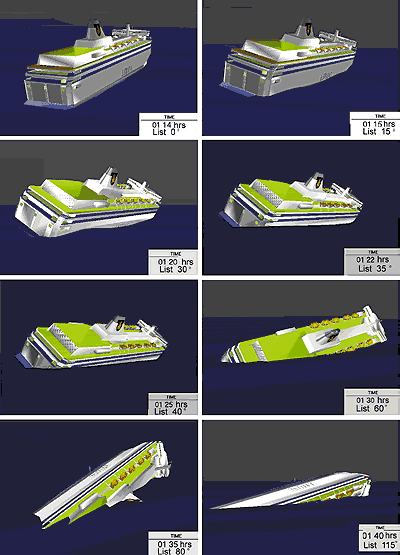
Continues... |
 |

